Ancient City Of Hippos-Sussita And The Mysterious Disc-Shaped Copper Plates
Ellen Lloyd - AncientPages.com - Here is a little ancient mystery for you to solve.
Some years ago, archaeologists unearthed four mysterious ancient copper plates close to a necropolis of the ancient city of Hippos-Sussita, located at the top of a diamond-shaped mountain 1,000 feet above the eastern shore of the Sea of Galilee.
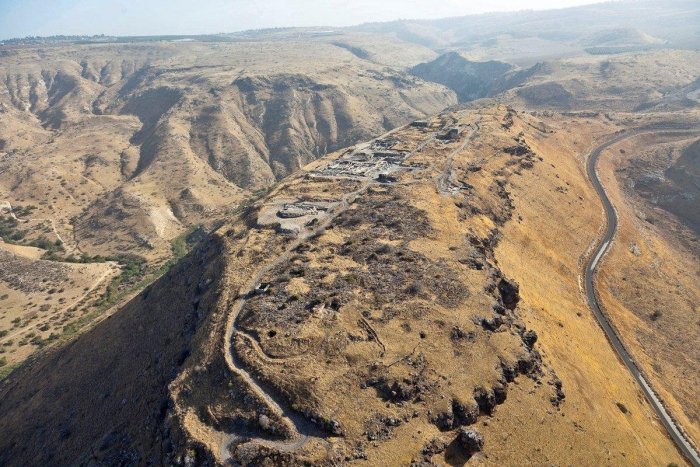
The excavated remains of Hippos, an aerial view. Credits: Michael Eisenberg/Hippos Excavation Project
Many theories have been presented, but we still don’t know the purpose of the copper plates. What were they used for? Some have suggested they were ancient musical instruments. Others say they were ancient shields used in battles.
The four copper plates still baffle archaeologists and the age of the artifacts remains unknown.
The Ancient City Of Hippos-Sussita
The ancient city was established in 200 B.C. it was fist called Sussita and later Hippos. Both the Greek name Hippos and the Aramaic name Sussita both mean “horse.” Hippos- Sussita was first inhabited by people who worshipped Greek gods, later came the Jews and finally, it became a Christian city with eight magnificent churches.
It seems Hippos-Sussita was never meant to exist because nature put an end and to the city’s prosperity.
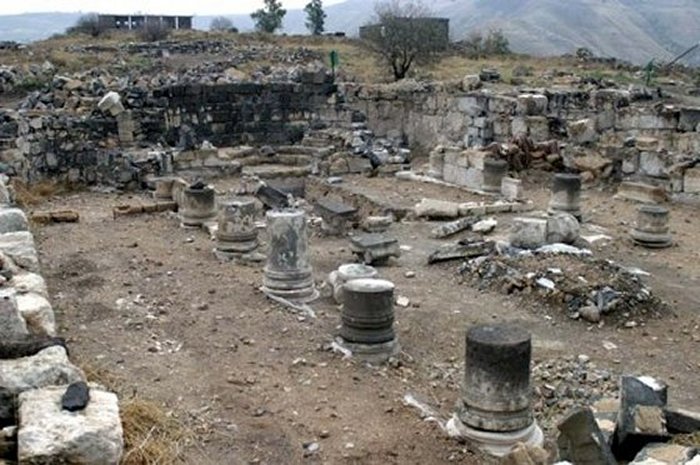
There is not much left of the ancient city of Hippos-Sussita. Image credit: Michael Eisenberg/Hippos Excavation Project
On January 18, 749 C.E., a powerful earthquake destroyed the ancient city. All churches and other buildings were ruined and Hippos-Sussita was never inhabited again after that catastrophe.
In 2000, a major modern archaeological excavation was begun and continues to this day. During this time, archaeologists have unearthed many valuable artifacts that shed light on the past of Hippos-Sussita.
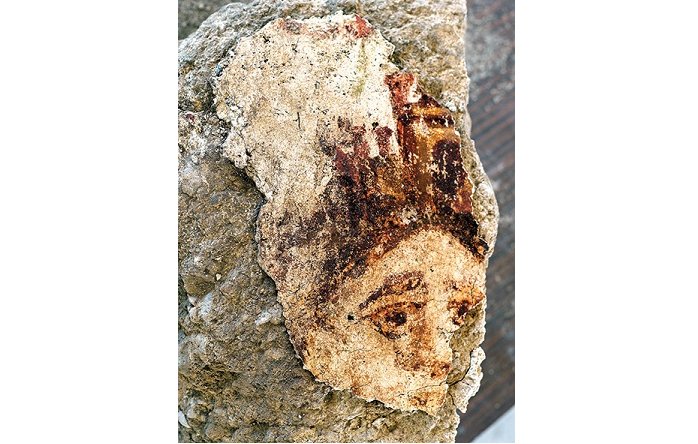
A fresco of the Greek goddess Tyche was preserved in a peristyle home in the Decapolis city of Hippos-Sussita. Photo: Hippos-Sussita Excavations Project.
In an article called “ Archaeological High Horse” in the November/December 2014 issue of Biblical Archaeology Review it was reported that scientists discovered remarkable ancient columns, a Hellenistic sanctuary, a forum, a small theater, a number of churches, numerous other structures and a standard main street known as the decumanus maximus.
Ancient Disc-Shaped Copper Plates Still Baffle Archaeologists
In 2013, archaeologists discovered four disk-shaped copper plates in the Hippos necropolis. According to the project leader, Dr. Michael Eisenberg of the Zinman Institute of Archaeology at the University of Haifa, Israel, all four copper plates were found very near to robbed and open graves. The plates were found during a metal detector survey. The artifacts were first ignored because they looked so modern. It was only later that scientists became interested in these curious objects.
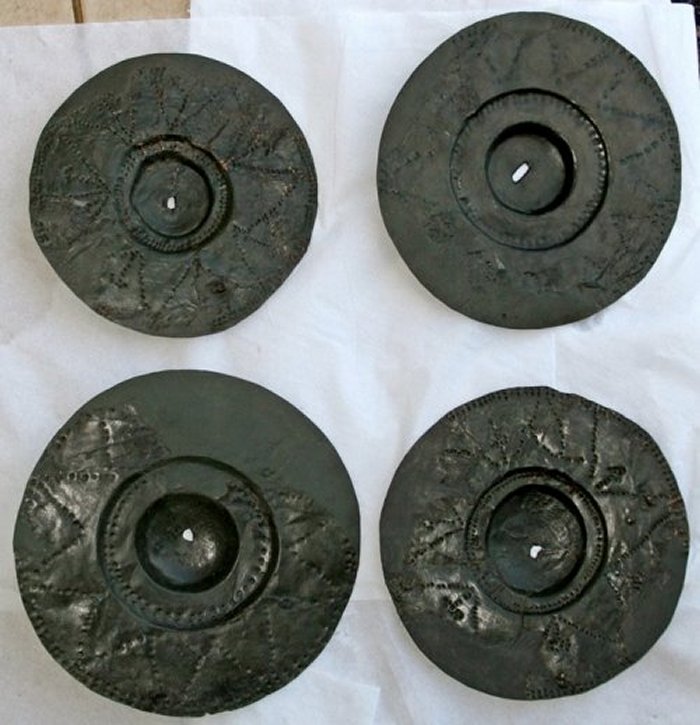
The four plates, showing the "inner" sides with decorative incisions and apparent nail marks. Courtesy Michael Eisenberg and the Hippos Excavation Project
The disk-shaped plates, approximately 20 cm in diameter feature what appear to be incisions in a decorative pattern on what has been interpreted as their inner sides, with clear marks of nails and a hole in the middle of each.
According to Dr. Eisenberg, the necropolis is probably dated to the broad Hellenistic-Byzantine time range, as does the nearby Hippos-Sussita polis, which has been extensively excavated.
However, the plates were found outside of graves, not inside, so it is difficult to determine the provenance as they could not be associated with surrounding artifacts and human remains within the internments.
"The plates seemed to have been thrown out of the graves by ancient robbers," says Dr. Eisenberg, who suspects that the relics were first exposed as a result of looting.
What were the ancient copper plates used for?
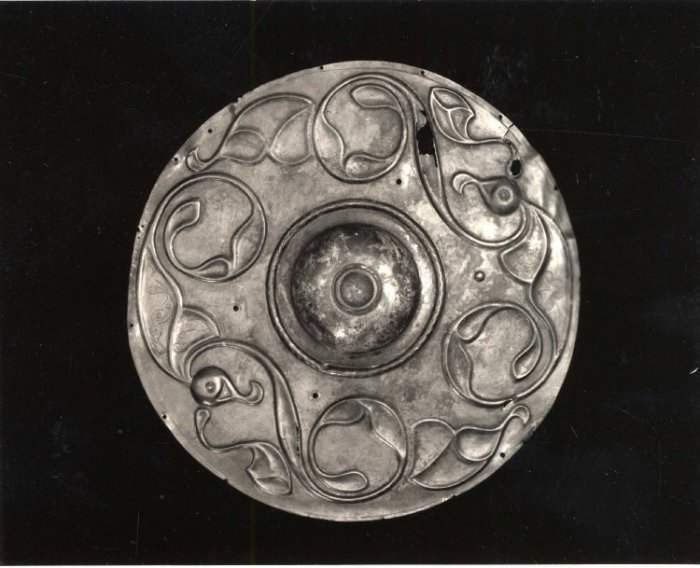
The Wandsworth Shield - Image credit: British Museum
The plates remind of military bronze shields used by for example Etruscans. The Wandsworth Shield is a circular bronze Iron Age shield boss discovered in the River Thames at Wandsworth in London around 1849 is also similar to copper plates found at Hippos-Sussita.
Then again, perhaps the disk-shaped copper plates might have been produced for another reason we have not been able to figure out.
Written By - Ellen Lloyd AncientPages.com
Copyright © AncientPages.com All rights reserved. This material may not be published, broadcast, rewritten or redistributed in whole or part without the express written permission of AncientPages.com
Expand for referencesMore From Ancient Pages
-
 Ancient Egyptians Observed Algol’s Eclipses – Cairo Calendar Analyzed
Archaeology | Dec 19, 2015
Ancient Egyptians Observed Algol’s Eclipses – Cairo Calendar Analyzed
Archaeology | Dec 19, 2015 -
 Unique Ancient Coast Salish War Club Accidently Discovered In British Columbia Backyard
Archaeology | Mar 22, 2022
Unique Ancient Coast Salish War Club Accidently Discovered In British Columbia Backyard
Archaeology | Mar 22, 2022 -
 Pyramid Texts Of Ancient Egypt That Charted Journey Of Pharaohs Into Afterlife
Egyptian Mythology | Feb 26, 2020
Pyramid Texts Of Ancient Egypt That Charted Journey Of Pharaohs Into Afterlife
Egyptian Mythology | Feb 26, 2020 -
 Wasabi Plant Can Save Ancient Bio-Deteriorated Papyrus
Scripts, Paintings & Inscriptions | Apr 4, 2024
Wasabi Plant Can Save Ancient Bio-Deteriorated Papyrus
Scripts, Paintings & Inscriptions | Apr 4, 2024 -
 How Ramesses II Became The Greatest Pharaoh In Egypt
Featured Stories | Jun 6, 2021
How Ramesses II Became The Greatest Pharaoh In Egypt
Featured Stories | Jun 6, 2021 -
 Trident: Powerful Religious Symbol Found In Many Ancient Cultures
Ancient Symbols | Dec 4, 2019
Trident: Powerful Religious Symbol Found In Many Ancient Cultures
Ancient Symbols | Dec 4, 2019 -
 Armenians’ Origin Theory By Herodotus Debunked By New DNA Study
DNA | Nov 27, 2024
Armenians’ Origin Theory By Herodotus Debunked By New DNA Study
DNA | Nov 27, 2024 -
 Daily Life Of Télpochcalli Students Of The Aztec Empire Was A Challenge
Ancient History Facts | Apr 20, 2020
Daily Life Of Télpochcalli Students Of The Aztec Empire Was A Challenge
Ancient History Facts | Apr 20, 2020 -
 MUL.APIN Tablets: Babylonian Knowledge Of Astronomy And Astrology Recorded In Cuneiform Writing
Artifacts | Sep 27, 2019
MUL.APIN Tablets: Babylonian Knowledge Of Astronomy And Astrology Recorded In Cuneiform Writing
Artifacts | Sep 27, 2019 -
 Evidence Of An Unknown Neolithic Society At Oued Beht In North Africa Discovered
Archaeology | Sep 30, 2024
Evidence Of An Unknown Neolithic Society At Oued Beht In North Africa Discovered
Archaeology | Sep 30, 2024 -
 Why Is Rome Called ‘The Eternal City’?
Ancient History Facts | May 16, 2024
Why Is Rome Called ‘The Eternal City’?
Ancient History Facts | May 16, 2024 -
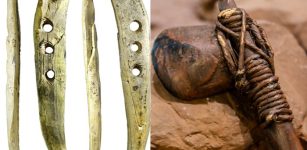 Rare Mammoth Ivory Tool Offers Evidence Of Ropemaking In Central Europe More Than 35,000 Years Ago
Archaeology | Feb 5, 2024
Rare Mammoth Ivory Tool Offers Evidence Of Ropemaking In Central Europe More Than 35,000 Years Ago
Archaeology | Feb 5, 2024 -
 Pre-Columbian Societies Declined 2,000 Years Ago Due To Sea Level Fall
Archaeology | Dec 22, 2021
Pre-Columbian Societies Declined 2,000 Years Ago Due To Sea Level Fall
Archaeology | Dec 22, 2021 -
 Curious Historical Observation Of A Bronze Age Warrior Who Shouldn’t Exist
Featured Stories | May 21, 2019
Curious Historical Observation Of A Bronze Age Warrior Who Shouldn’t Exist
Featured Stories | May 21, 2019 -
 Ancient Textile Mystery: King Canute Enshrined In His Own Clothes But Found In His Brother’s
Artifacts | Oct 5, 2020
Ancient Textile Mystery: King Canute Enshrined In His Own Clothes But Found In His Brother’s
Artifacts | Oct 5, 2020 -
 Famous Viking Ragnar Lodbrok – Legendary Fearless Sea-King Of The North
Featured Stories | Apr 24, 2016
Famous Viking Ragnar Lodbrok – Legendary Fearless Sea-King Of The North
Featured Stories | Apr 24, 2016 -
 What Was The Law Of The Innocents?
Ancient History Facts | Feb 10, 2016
What Was The Law Of The Innocents?
Ancient History Facts | Feb 10, 2016 -
 Earliest Evidence Of Flip Flops In The Middle Stone Age
Archaeology | Oct 27, 2023
Earliest Evidence Of Flip Flops In The Middle Stone Age
Archaeology | Oct 27, 2023 -
 New Evidence Of Roman And Medieval Leicester
Archaeology | Dec 10, 2015
New Evidence Of Roman And Medieval Leicester
Archaeology | Dec 10, 2015 -
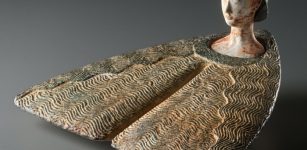 Strange Flat Idol Sculpture From Bactria Remains Unexplained
Artifacts | Sep 26, 2019
Strange Flat Idol Sculpture From Bactria Remains Unexplained
Artifacts | Sep 26, 2019
